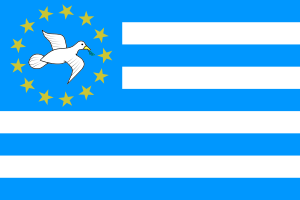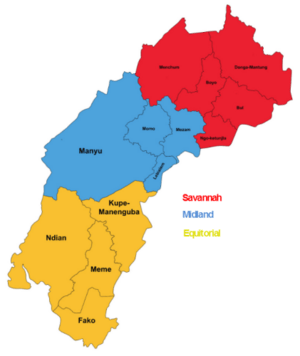Southern Cameroons facts for kids
Quick facts for kids Southern Cameroons |
|||||||||||
|---|---|---|---|---|---|---|---|---|---|---|---|
| Part of the Cameroons | |||||||||||
| 1916–1961 | |||||||||||
|
|
|||||||||||
 The Southern Cameroons now constitute the Southwest Region and Northwest Region. |
|||||||||||
| Capital | Buea | ||||||||||
| Area | |||||||||||
|
• 1987
|
42,710 km2 (16,490 sq mi) | ||||||||||
| Population | |||||||||||
|
• 1987
|
2,100,000 | ||||||||||
| History | |||||||||||
| 1916 | |||||||||||
|
• Federated with French Cameroons
|
1 October 1961 | ||||||||||
|
|||||||||||
The Southern Cameroons was a territory in West Africa. It was the southern part of the land that the British managed after World War I. Since 1961, this area has been part of the country of Cameroon. Today, it makes up the Northwest Region and Southwest Region of Cameroon.
Since 1994, some groups in the Southern Cameroons have been working to become an independent country again. They believe there was no proper agreement when they joined Cameroon. They call this area Ambazonia.
Contents
History
League of Nations Mandate
After World War I, Germany lost its territory of Kamerun. On June 28, 1919, this land was split between France and Britain. France got the larger part, which became known as Cameroun. Britain received two smaller parts: Northern Cameroons and Southern Cameroons.
The British managed these territories from Nigeria. The main office was in Buea. The British used a system called "indirect rule." This meant they allowed local leaders to govern their people using their own traditions. These local leaders also collected taxes for the British. The British mainly focused on trade and finding valuable resources in the land.
In 1940, students from Southern Cameroons, including Emmanuel Mbela Lifafa Endeley, formed the Cameroons Youth League (CYL). They wanted to stop what they saw as unfair use of their country's resources.
Trust Territory
In 1946, the League of Nations ended. Many of its territories, including British Cameroons, became UN trust territories. The goal was to help these lands prepare for independence. The United Nations agreed that Britain would manage British Cameroons starting December 6, 1946.
In 1949, Southern Cameroons was divided into two areas: Bamenda and Southern. However, it was still managed by one British Resident in Buea. In 1954, Southern Cameroons gained more political power. E.M.L. Endeley became its first Premier.
As Cameroun (French-managed) and Nigeria prepared to become independent, people in Southern Cameroons debated their future. Should they join Cameroun, join Nigeria, or become fully independent? In 1959, John Ngu Foncha defeated Endeley in an election.
Referendums (votes by the people) were held in 1959 and 1961. In 1961, Northern Cameroons voted to join Nigeria. Southern Cameroons voted to join Cameroun, which had been managed by France.
Ambazonian Independence Movement
Southern Cameroons officially became part of Cameroon on October 1, 1961. John Foncha became the Prime Minister of West Cameroun and the vice-president of the new Federal Republic of Cameroun. However, the English-speaking people of Southern Cameroons (now West Cameroun) felt they were not treated fairly by the French-speaking government.
In 1972, Cameroon changed its constitution. It became a unitary state instead of a federal one. This meant Southern Cameroons lost its special self-governing status. It became the Northwest Province and Southwest Province. Many Southern Cameroonians felt even more left out. Groups like the Cameroon Anglophone Movement (CAM) started asking for more self-rule or even full independence.
Groups wanting independence say that a UN resolution from 1961 was not followed. This resolution asked Britain, Southern Cameroons, and Cameroon to talk about how they would unite. They believe Britain did not make sure proper plans were in place before ending its role. They also say that when Cameroon adopted a new constitution in 1961, it was like taking over Southern Cameroons without full agreement.
English-speaking groups held a meeting in Buea in 1993. They asked for the 1961 federal system to be brought back. Another meeting in 1994 said that if the federal system was not restored, Southern Cameroons would declare independence. These groups later formed the Southern Cameroons National Council (SCNC).
In 1995, the SCNC sent a group, led by John Foncha, to the United Nations. They presented a request against the "takeover" of Southern Cameroons. The same year, organizers claim a vote was held where 99% of 315,000 people voted for independence.
On December 30, 1999, armed members of the SCNC took over a radio station in Buea. They broadcast a message declaring independence for Southern Cameroons.
Amnesty International has reported that the Cameroon government has violated the human rights of Southern Cameroons activists.
Southern Cameroons, now often called Ambazonia, joined the Unrepresented Nations and Peoples Organization (UNPO) in 2005.
Here are some of the proposed areas within Ambazonia:
| Ambazonia County | ||||||||
|---|---|---|---|---|---|---|---|---|
| County | Capital | Area (km2) | ||||||
| Fako | Victoria | 2,093 | ||||||
| Meme | Kumba | 3,105 | ||||||
| Ndian | Mundemba | 6,626 | ||||||
| Kupe-Manengouba | Bangem | 3,404 | ||||||
| Lebialem | Menji | 617 | ||||||
| Manyu | Mamfe | 9,565 | ||||||
| Momo | Mbengwi | 1,792 | ||||||
| Mezam | Bamenda | 1,745 | ||||||
| Ngoketundjia | Ndop | 1,126 | ||||||
| Bui | Kumbo | 2,297 | ||||||
| Boyo | Fundong | 1,592 | ||||||
| Menchum | Wum | 4,469 | ||||||
| Donga Mantung | Nkambe | 4,279 | ||||||
| State | Capital | Area (km2) | Population (2015) |
|---|---|---|---|
| Equatorial (Atlantic) | Kumba | 15,228 | 2,618,138 |
| Midland | Widikum | 13,719 | 2,454,795 |
| Savannah | Kumbo | 13,763 | 2,733,032 |
| F.R.A. | Buea | 42, 710 | 7,805,965 |
Complaint with the African Commission on Human and Peoples Rights
In 2003, the SCNC and SCAPO groups complained to the African Commission on Human and Peoples' Rights. They claimed that Cameroon was illegally occupying Southern Cameroons. They also said Cameroon had violated many human rights. The groups wanted Southern Cameroons to become independent.
In 2009, the African Commission decided that Cameroon had indeed violated some human rights. The Commission also agreed that the people of Southern Cameroons fit the definition of a "people" under international law. This is because they share a common history, language, land, and political views.
However, the Commission could not rule on events that happened before December 18, 1989. This was when the African Charter on Human and Peoples' Rights became law for Cameroon. But the Commission said it could look at violations that started before that date and continued afterward.
The Commission looked at whether the people of Southern Cameroons had the right to self-determination (to decide their own future). It said that to claim this right, they must show they have faced oppression or domination. The Commission noted that the groups had not fully shown these conditions for events after 1989.
The Commission also said that self-rule within a country, like a federation, is possible while keeping the country's borders.
Finally, the Commission suggested that Cameroon should talk with the SCNC and SCAPO. The goal of these talks would be to solve the issues and complaints about the constitution.
Leadership
This table shows the leaders of Southern Cameroons and West Cameroon:
| No. | Portrait | Name (Birth–Death) |
Election | Term of office | Political party | President | ||
|---|---|---|---|---|---|---|---|---|
| Took office | Left office | Time in office | ||||||
| Premier of British Southern Cameroons | ||||||||
| 1 | 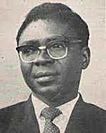 |
E. M. L. Endeley (1916–1988) |
1957 | 1 October 1954 | 1 February 1959 | 4 years, 153 days | KNC | |
| 2 | 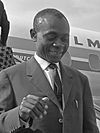 |
John Ngu Foncha (1916–1999) |
1959 | 1959 | 1 October 1961 | 2 years, 212 days | KNDP | |
| Prime Minister of West Cameroon (Federal Republic of Cameroon) | ||||||||
| 1 |  |
John Ngu Foncha (1916–1999) |
1964 | 1 October 1961 | 13 May 1965 | 3 years, 224 days | KNDP | Ahidjo |
| 2 | 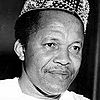 |
Augustine Ngom Jua (1929–1977) |
— | 13 May 1965 | 1 September 1966 | 2 years, 243 days | KNDP | |
| (2) | 1 September 1966 | 11 January 1968 | UNC | |||||
| 3 |  |
Salomon Tandeng Muna (1912–2002) |
1970 | 11 January 1968 | 2 June 1972 | 4 years, 143 days | UNC | |
Bakassi Peninsula
The Bakassi peninsula is a piece of land near the coast. In 2002, the International Court of Justice decided that Bakassi belonged to Cameroon. However, the SCAPO group claimed that Bakassi was actually part of Southern Cameroons.
In 2002, SCAPO took the Nigerian government to court. They wanted Nigeria to ask the International Court of Justice to confirm Southern Cameroons' right to self-determination. The court ruled in SCAPO's favor. On August 14, 2006, Nigeria gave the Bakassi peninsula to Cameroon. In response, SCAPO declared the independence of the Republic of Ambazonia, saying Bakassi was part of it.
See also






